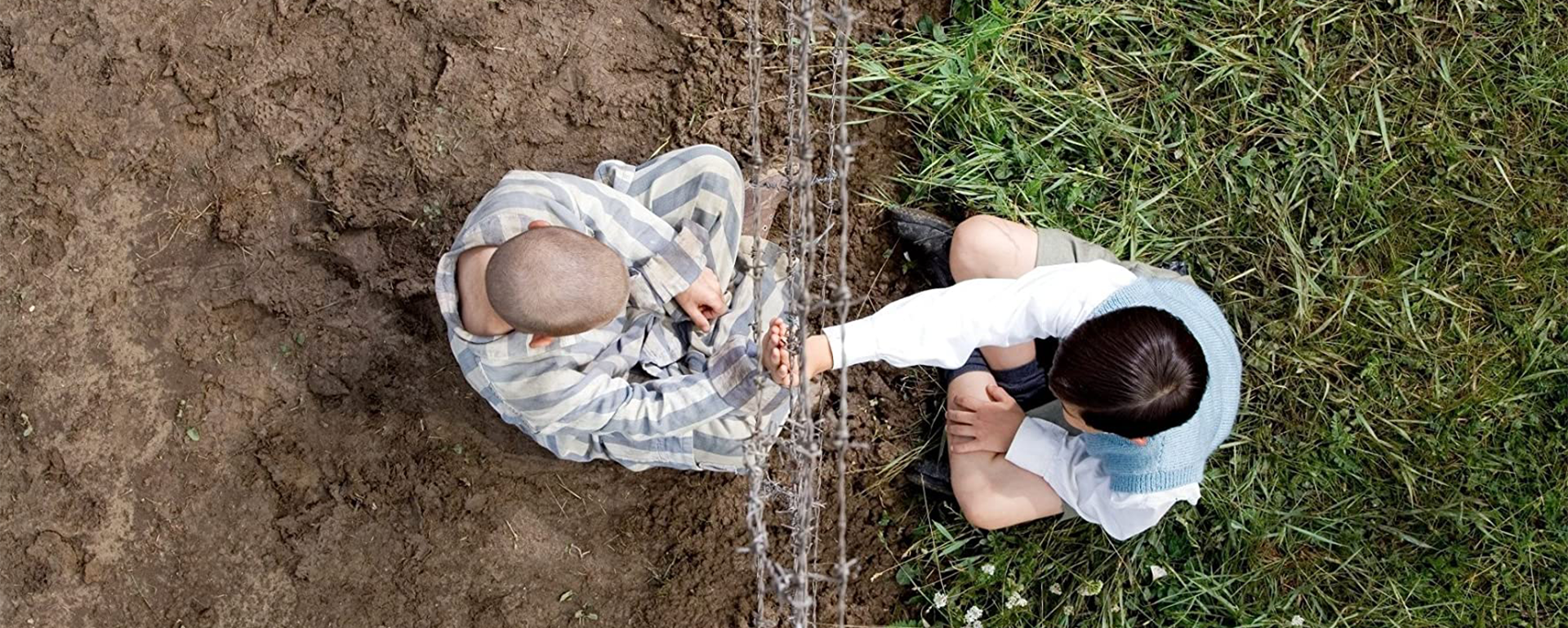
The Boy In The Striped Pyjamas
The Boy In The Striped Pyjamas is an adaptation of a best-selling novel, which appealed both to young teenage and adult audiences. Set during World War II, it tells of Bruno, the young son of a camp Commandant. Unaware of the camp’s real aims, and bored after moving from his city home, Bruno forges a secret (and forbidden) friendship with a young Jewish boy, Shmuel, a little boy of his own age that he sees on the other side of the camp fence. As the war progresses his mother becomes increasingly concerned that the camp is no place for children.
It is a British film (from the producer of the Harry Potter series) and arrived at the BBFC with no category request. This means the film’s distributors didn’t ask for any particular certificate.
The film views the Holocaust through the eyes of an eight-year-old boy, ignorant of many of the stronger prejudices of his family and his father’s Nazi friends and unaware of the degree of murder and violence which takes place near his house. For example, he believes the camp to be a farm, and the uniforms to be pyjamas. The enormity and genuine horror of what happens on the 'farm' is only occasionally and discreetly hinted at throughout the film until the final sequence. He also develops an equal and honest friendship with the camp prisoner Shmuel.
Despite the Holocaust theme, most of the early part of the film could be comfortably contained at PG. There are some strong antisemitic remarks, but these are made by unsympathetic German characters clearly signposted as wrong, and viewed with increasing suspicion and horror by Bruno and his mother.
At PG the BBFC Guidelines state that where more serious issues are featured nothing in their treatment should condone unacceptable behaviour. They also have a note on discrimination which requires that ‘Discriminatory language or behaviour is unlikely to be acceptable unless clearly disapproved of or in an educational or historical context. Discrimination by a character with which children can readily identify is unlikely to be acceptable.’
The work has a clear historical context, and moral arc which demonstrates that the violently racist and antisemitic views displayed by the Nazi characters are wrong. Indeed, Bruno’s lie about being friends with the Jewish boy, which gets his friend beaten, is shown to cause him considerable distress and immediate remorse.
There are some situations of threat but these are mild, and counterbalanced by the reassuring presence of a parent figure (Bruno's mother always close at hand). The violence is implied (it is mostly heard or suggested off screen) and lacks any gory detail.
The Holocaust has been explored at PG before, for example, in Roberto Benigni's Oscar winning Life Is Beautiful. Examiners noted that The Boy In The Striped Pyjamas would probably appeal to older children and their parents given the book’s popularity. In addition, the story is told almost exclusively from the little boy’s point of view which adds to the film’s treatment of grown up and horrific ideas in a way that reinforces younger viewer’s natural sense of right and wrong, whilst gently exploring the terrible things of which the human race is capable.
Unaccompanied children of any age may watch a PG film and the BBFC Guidelines note that a PG film ‘should not disturb a child aged around eight or older’. Parents are warned that sometimes at PG ‘content may upset younger or more sensitive children’.
The concentration camp theme occupies the background of the story, and most of the film examiners noted that the genuine horrors of the Holocaust are only occasionally and discreetly hinted at. Suddenly however, at the film’s climax, this alters and the work shows the film's central (child) protagonist, and his friend gassed to death in a chamber. It is designed to be a shocking twist and the film ends on this downbeat and emotionally moving sequence, offering no positive resolution or happy ending. Though brief, the scenes building up to the gassing are scary and intense, not least given the ramped up fear on the part of Bruno, his friend and the men from the camp they are being herded in with.
At PG, Guidelines state that ‘frightening sequences should not be prolonged or intense’ (though fantasy settings may be a mitigating factor). It was felt that, though not particularly long, the sequence was intense and emotionally challenging, with no respite – when the camera cuts away it is to Bruno’s increasingly panic stricken and then devastated family searching for him.
Internal guidelines for examiners which look at how children’s films are usually classified also note that ‘Scenes which are likely to generate significant emotional responses must be balanced by reassurance (e.g. from authority figures) and lighter moments, and an eventual ‘happy’ ending or suitable resolution.’
Examiners concluded that the work was best placed at 12A, where it could be seen by younger viewers with their parents, but also be available for younger teenage viewers, including those who had read or studied the book, to watch it if they wished.
The BBFC Guidelines allows for difficult themes, such as the atrocities of war, to be explored in works classified at 12A. The tone and treatment of the subject, however, is critical to presenting such themes at this category. For example, Hotel Rwanda dealt with the horror of the Rwandan genocide and its impact on a family; the recent film adaptation of The Kite Runner explored the friendship of two boys during the Russian invasion of Afghanistan and the imposition of Taliban rule. Both films were classified at 12A for the discreet and sensitive handling of such troubling subjects.
Though examiners felt this film sat at the PG / 12A borderline, there were a handful of complaints from cinema-goers who were concerned the film was too moving and upsetting for audiences of under 12 years old, accompanied by an adult.